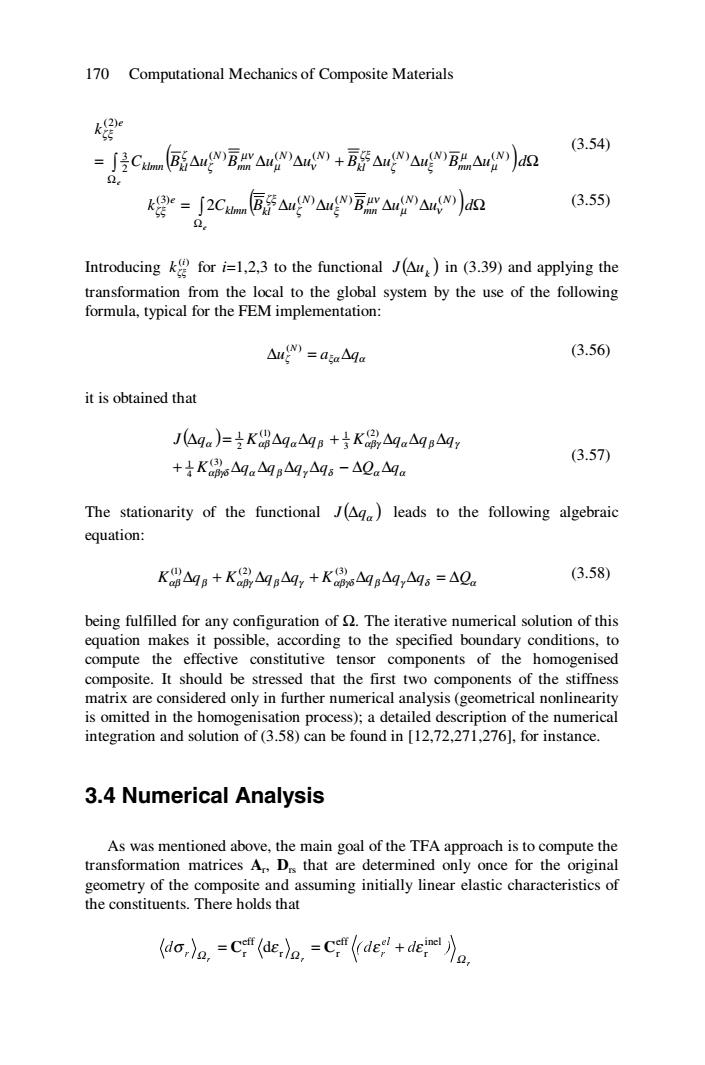正在加载图片...

170 Computational Mechanics of Composite Materials (3.54) =J房Cm@号△△ArW+Bf△A△d k2=∫2Chn同△n△△r△)a (3.55) Ω Introducingk for i=1,2.3 to the functional (Au)in(3.39)and applying the transformation from the local to the global system by the use of the following formula,typical for the FEM implementation: △ng=asa△qa (3.56) it is obtained that J△qa)=Kw△qa△qB+K编△qa△qB△q7 (3.57) +tKs△qa△qB△q,△qs-△0.△ga The stationarity of the functional /(Ada)leads to the following algebraic equation: Kw△qB+KAqB△q,+Ks△qB△q,Aq6=△0 (3.58) being fulfilled for any configuration of The iterative numerical solution of this equation makes it possible,according to the specified boundary conditions,to compute the effective constitutive tensor components of the homogenised composite.It should be stressed that the first two components of the stiffness matrix are considered only in further numerical analysis(geometrical nonlinearity is omitted in the homogenisation process);a detailed description of the numerical integration and solution of (3.58)can be found in [12,72,271,276],for instance. 3.4 Numerical Analysis As was mentioned above,the main goal of the TFA approach is to compute the transformation matrices A,,Ds that are determined only once for the original geometry of the composite and assuming initially linear elastic characteristics of the constituents.There holds that (da,=C(de,)C(des+de)170 Computational Mechanics of Composite Materials ( ) ∫ Ω = ∆ ∆ ∆ + ∆ ∆ ∆ Ω e C B u B u u B u u B u d k N mn N N kl N N mn N klmn kl e ( ) ( ) ( ) ( ) ( ) ( ) 2 3 (2) µ µ ζ ξ ζξ µ ν µν ζ ζ ζξ (3.54) ∫ ( ) Ω = ∆ ∆ ∆ ∆ Ω e k C B u u B u u d N N mn N N klmn kl (3)e ( ) ( ) ( ) ( ) 2 µ ν µν ζ ξ ζξ ζξ (3.55) Introducing (i) kζξ for i=1,2,3 to the functional ( ) k J ∆u in (3.39) and applying the transformation from the local to the global system by the use of the following formula, typical for the FEM implementation: uζ aξα qα N ∆ = ∆ ( ) (3.56) it is obtained that ( ) αβγδ α β γ δ α α α αβ α β αβγ α β γ K q q q q Q q J q K q q K q q q + ∆ ∆ ∆ ∆ − ∆ ∆ ∆ = ∆ ∆ + ∆ ∆ ∆ (3) 4 1 (2) 3 (1) 1 2 1 (3.57) The stationarity of the functional ( ) α J ∆q leads to the following algebraic equation: Kαβ∆qβ + Kαβγ∆qβ∆qγ + Kαβγδ∆qβ∆qγ∆qδ = ∆Qα (1) (2) (3) (3.58) being fulfilled for any configuration of Ω. The iterative numerical solution of this equation makes it possible, according to the specified boundary conditions, to compute the effective constitutive tensor components of the homogenised composite. It should be stressed that the first two components of the stiffness matrix are considered only in further numerical analysis (geometrical nonlinearity is omitted in the homogenisation process); a detailed description of the numerical integration and solution of (3.58) can be found in [12,72,271,276], for instance. 3.4 Numerical Analysis As was mentioned above, the main goal of the TFA approach is to compute the transformation matrices Ar, Drs that are determined only once for the original geometry of the composite and assuming initially linear elastic characteristics of the constituents. There holds that r r r d ( d d ) el r r Ω Ω Ω σ ε ε εinel r eff r r eff r = C d = C +